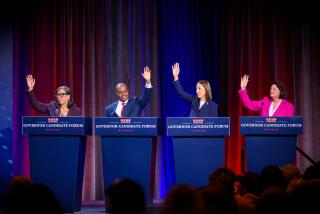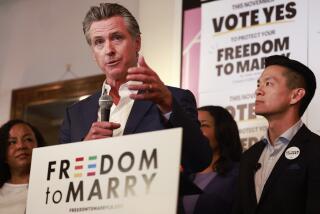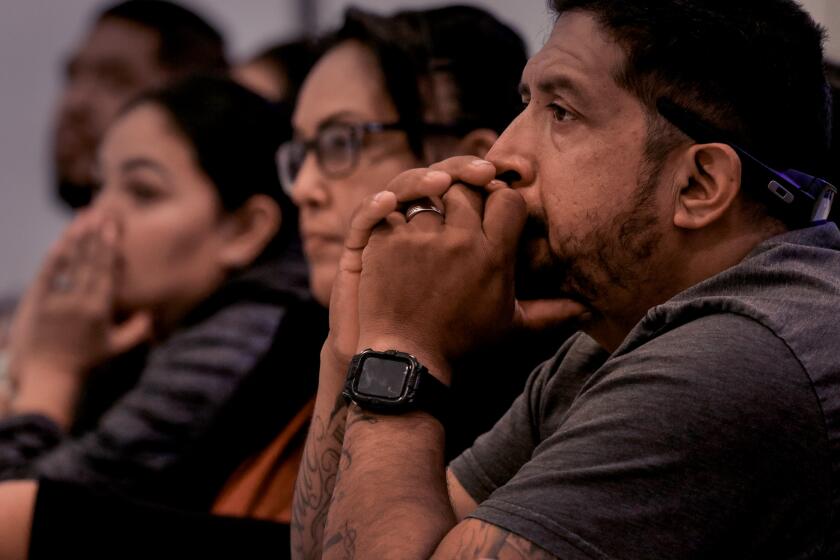More than a dozen candidates vie for lieutenant governor
California’s lieutenant governor generally doesn’t have a lot to do. And the post rarely serves as a springboard to the governor’s office. Yet the position has again attracted a robust roster of candidates — 13 in all — and competitive contests have emerged on both the Republican and Democratic sides ahead of the June 8 primary election.
San Francisco Mayor Gavin Newsom altered the Democratic dynamics in March when he made his last-minute entry into a contest for an office he had disparaged. That raised the stakes for Los Angeles Councilwoman Janice Hahn, who until then had been heavily favored to win the nomination over a single unknown, underfunded competitor.
Among Republicans, moderate Abel Maldonado can claim incumbency as he tries to finish first among six GOP candidates. He was appointed to fill the remainder of the term that John Garamendi left open after being elected to Congress late last year. Maldonado’s competition includes conservative state Sen. Sam Aanestad of Grass Valley and conservative Orange County attorney Scott L. Levitt.
These five candidates have raised or spent at least $50,000 on their campaigns, according to reports they filed with the secretary of state’s office.
Besides waiting to step into the top job whenever the governor leaves the state or is incapacitated, the lieutenant governor sits on the State Lands Commission, which oversees the state’s land holdings and navigable waterways and considers such hot-button issues as offshore oil drilling; and on the governing boards of the University of California and California State University systems. The officeholder also chairs the state Economic Development Commission and is president of the state Senate, where he or she can vote only to break a tie.
“It’s not a meaningless job,” USC political scientist Sherry Bebitch Jeffe said of the office that some — including this newspaper — have suggested abolishing.
In a state where term limits keep career politicians constantly on the lookout for the next elected post, the job is seen as a stepping stone.
“In a way, it’s a great job,” said John J. Pitney Jr., a professor of politics at Claremont McKenna College.
He noted that a lieutenant governor, without a lot of duties or other obligations, can find occasion to go anywhere in the state and raise his or her visibility. “It’s a good credential when you run for something else. And that’s really the point of running for lieutenant governor . . . a great way to keep your options open.”
Those options rarely include the governor’s office. According to California State Library researchers, only two lieutenant governors have won election to the top job: C.C. Young, who governed from 1927 to 1931, and Gray Davis, who served from 1999 until he was recalled in 2003.
Like Garamendi, lieutenant governors sometimes get elected to other posts. Mervyn Dymally, for example, went to Congress and later to the state Assembly after serving in the 1970s.
On the Democratic side of the current contest, Hahn, 58, who represents Los Angeles’ Harbor area as well as Watts and other blue-collar, strongly minority neighborhoods, is positioning herself as the candidate of the working class. Her father, longtime Los Angeles County Supervisor Kenneth Hahn, was beloved in the African American community, and Janice Hahn is emphasizing the ethnic diversity of her supporters.
Hahn promises to focus on “the four E’s” — economy and jobs, education, environment and the empowerment of local government. She also likes to point out that she would make history as the first woman to hold the lieutenant governor post.
She has been a strong supporter of employee unions and has endorsements from the influential Los Angeles County Federation of Labor, the state Service Employees International Union and several public safety associations, among others. However, Newsom also is regarded as a “friend of labor” and has endorsements and a track record that may dilute the value of Hahn’s labor backing. As city officials, both must address the politically dicey issue of job cuts as they seek to help their cities weather budget troubles.
Before and after he dropped out of the governor’s race last fall, citing fundraising difficulties and a desire to spend more time with his newborn daughter, Newsom called the lieutenant governor job largely ceremonial. Hahn seized on that, saying she really wanted what she considered “an important job,” while Newsom “has almost kind of made fun of it.” He said he has since gained a better understanding of the role and sees opportunities to shape economic policy and help oversee the state university systems.
Newsom, 42, earned national visibility by issuing marriage licenses to same-sex couples in 2004. He has been racking up endorsements from many of the state’s Democratic elected officials, including House Speaker Nancy Pelosi and U.S. Sen. Dianne Feinstein, both fellow San Franciscans. Some politically prominent Angelenos have signed on too, including former Assembly Speaker Robert Hertzberg. Newsom also has the backing of the California League of Conservation Voters. The campaign has emphasized his role in bringing “green” jobs to the city and developing a healthcare plan for uninsured residents.
Also on the Democratic ballot is scientist/father/businessman Eric Korevaar of La Jolla.
On the Republican side, Maldonado, 42, has made no secret of his political ambitions. The son of immigrants from Mexico, Maldonado grew up working in strawberry fields alongside his parents and helped run the family farm. Frustration over a business permit prompted him to run for Santa Maria City Council; from there he moved on to mayor, assemblyman and state senator.
Maldonado made headlines last year when he broke ranks with the GOP and provided a key budget vote — including a tax increase. In exchange, he insisted that the Legislature put a measure on next month’s ballot that would change the way primary elections are held in California; he says the measure would break the partisan logjam in Sacramento by improving the prospects of more centrist candidates.
If Maldonado hopes to hang on to his new job, he must find a way to mend fences with the GOP’s most conservative members. Aanestad has reminded voters of Maldonado’s tax vote at every opportunity. Party leaders also are angry at him over the ballot measure, which they and Democratic leaders strongly oppose.
Aanestad, 63, an oral surgeon and businessman, has spent 12 years in the Legislature, starting in the Assembly. He said he stands for “limited government and individual freedom.”
Making his first bid for elected office, attorney Levitt of Seal Beach said he is running to offer voters someone with “private sector experience who can implement a practical approach to governing.” Levitt, 37, also a licensed general contractor and a real estate broker, said he wants to reduce the size of government, taxes and regulations that “are destroying the free market system.”
Others on the Republican ballot are businessman Bert Davis of Stockton, judicial assistant Yvonne R. Girard of Riverside and businessman Dave Harris of Discovery Bay.
Four third-party candidates are unopposed for their respective parties’ nominations and therefore will appear on the November general election ballot.
More to Read
Get the L.A. Times Politics newsletter
Deeply reported insights into legislation, politics and policy from Sacramento, Washington and beyond. In your inbox three times per week.
You may occasionally receive promotional content from the Los Angeles Times.











